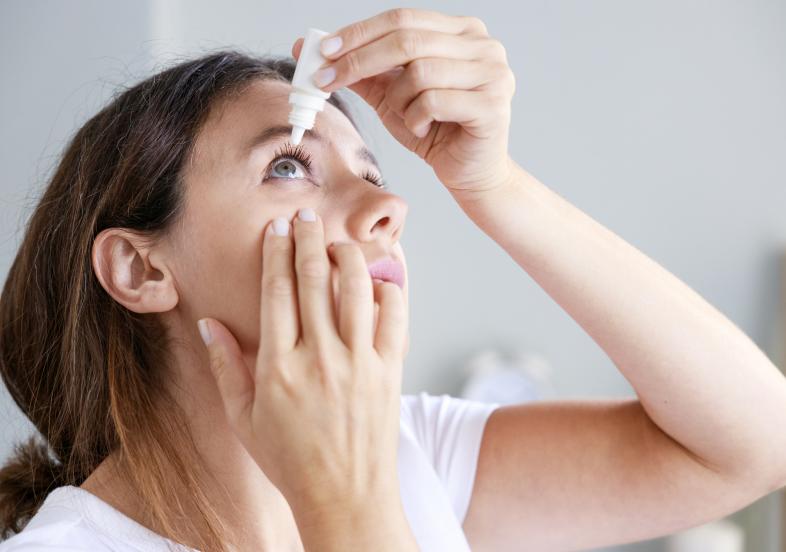
What is Dry Eye Disease?
Dry eye occurs when the eyes do not produce enough tears or produce tears that lack the right chemical composition. This leads to uncomfortable symptoms such as:
- Redness, stinging, or burning
- Grittiness or scratchiness
- A sensation of something in the eye
- In some cases, excessive tearing as the eye tries to compensate for dryness
While dry eye can affect anyone, certain groups including older adults, those taking certain medications, or those with underlying health conditions, are more likely to experience it.
What Causes It?
Many factors contribute to dry eye, including:
- Aging and hormonal changes
- Environmental triggers like wind, pollution, or dry indoor air
- Long hours of screen time and reduced blinking
- Certain medications (e.g., antihistamines, antidepressants, oral contraceptives)
- Health conditions such as rheumatoid arthritis, thyroid disease, and Sjögren’s Syndrome
Even genetics may play a role in predisposition to dry eye.
How is it Diagnosed and Treated?
An optometrist can diagnose dry eye using a combination of history-taking, slit lamp exams, imaging, and tear quality testing. Once diagnosed, management options include:
- Artificial tears and lubricating ointments
- Prescription medications to reduce inflammation and improve tear production
- Punctal plugs to slow tear drainage
- Heat or light-based therapies targeting the glands
- Lifestyle modifications: taking screen breaks, using a humidifier, staying hydrated, and protecting eyes from wind and sun
The Personal and Economic Impact of Dry Eye
Dry eye disease isn’t just a nuisance. It can reduce quality of life and work productivity. Research shows:
- Severe dry eye can cost up to $28,000 annually in direct and indirect costs, mostly due to presenteeism (working while symptomatic).1
- Dry eye disease is associated with absenteeism, presenteeism, impaired productivity, impaired activity and difficulty at work.2
- Mental health impacts are significant — people with dry eye are nearly 3 times more likely to experience anxiety or depression.3
- Sjögren’s Syndrome, a form of dry eye, is linked to lower employment rates and work disability. 2
This evidence supports the importance of recognizing and addressing the symptoms of dry eye, seeking a diagnosis, and treating the disease. Dry eye should not be dismissed or ignored by plan sponsors or by plan members.
What Can Be Done?
Stay informed about your eye health and visit your optometrist for a comprehensive eye exam every 12 to 24 months, depending on your age and risk factors. Early detection and treatment are key. Yet with little to no public vision coverage for working-age adults in many provinces, many people delay care. Group vision care benefits can help fill this gap, but most plans don’t cover diagnostics during initial examinations and follow-up visits for dry eye monitoring or treatment.
The Canadian Association of Optometrists recommends that a comprehensive vision care benefit should support the early detection and effective management of eye diseases like dry eye:
- Ensure a sufficient allowance for diagnostic imaging in your comprehensive exam benefit. Diagnostic imaging plays a critical role in identifying and monitoring conditions. An appropriate allowance ensures that optometrists can employ modern tools to assess eye health during comprehensive exams.
- Ensure diagnostic imaging is a covered service under your comprehensive eye exam benefit.
- Add an allowance for partial or follow-up examinations between comprehensive eye examinations. When an optometrist is monitoring an existing eye condition or suspects the existence of one, such as dry eye, glaucoma, or diabetic retinopathy, recall visits are required between routine comprehensive exams. Including a specific allowance for partial or follow-up visits helps ensure timely care, early intervention, and better outcomes for patients.
You will find more information on prevention, early detection and managing diseases through CAO blogs, podcasts, and webinars. Want to know more? You can find our handbook and blog posts here on the Don't Lose Sight website or contact the CAO for more information or assistance at info@opto.ca
References
- Chan C, Ziai S, Myageri V, Burns JG, Prokopich CL. Economic burden and loss of quality of life from dry eye disease in Canada. BMJ Open Ophthalmol. 2021;6(1):e000709. Published 2021 Sep 15. doi:10.1136/bmjophth-2021-000709
- Sivakumar GK, Patel J, Malvankar-Mehta MS, Mather R. Work productivity among Sjögren's Syndrome and non-Sjögren's dry eye patients: a systematic review and meta-analysis. Eye (Lond). 2021;35(12):3243-3257. doi:10.1038/s41433-020-01282-3
- Wan KH, Chen LJ, Young AL. Depression and anxiety in dry eye disease: a systematic review and meta-analysis. Eye (Lond). 2016;30(12):1558-1567. doi:10.1038/eye.2016.186